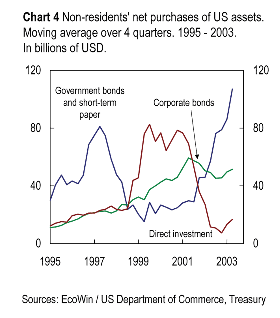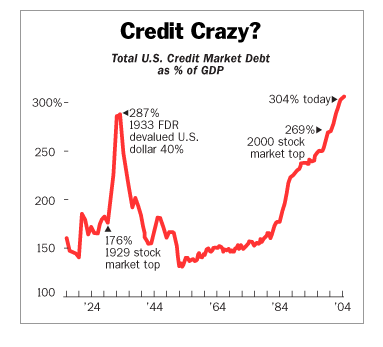

|
| weblog/wEssays | home | |
|
Another Day and Another (Billion) Dollar(s) in Debt--A Vicious Cycle (November 29. 2005)  Our Thanksgiving dinner guests included one of the handful of wizards who trade billions of dollars
of currencies each and every day for one of the big global money-center banks. His comments on the
U.S. dollar are worth considering.
Our Thanksgiving dinner guests included one of the handful of wizards who trade billions of dollars
of currencies each and every day for one of the big global money-center banks. His comments on the
U.S. dollar are worth considering.
Though he works in New York, he is an Asian national who keeps close tabs on the financial pulses of Asian central banks. To paraphrase his commentary: the U.S. dollar and the global financial system is in a vicious cycle of debt and dollar purchases. The Asian banks, he explains, don't want to see the U.S. dollar collapse, for they know that if the U.S. economy goes down, so does the rest of the world. They are also not keen on seeing their already-vast portfolio of U.S. bonds depreciate along with the dollar. So they keep buying dollars and U.S. debt; what other choice do they have? Our friend explained that everyone in the financial world knows the U.S. debt--$8 trillion and climbing at the Federal Government level, plus untold trillions in local government, corporate and private mortgage debt--is unsustainable, and a collapse of the dollar is inevitable; but the feeling is that the merry-go-round can spin a few more times before it flies apart.  He went on to explain that banks sitting on huge wads of yen in Japan, where bonds earn basically zero
percent return, look at 4.5% yields on bonds in the U.S. and reckon, why not make some quick money now
by buying U.S. debt? The merry-go-round still has a few turns left in it, so let's buy dollars (raising
the value of the dollar against the yen and other currencies) and buy U.S. Treasuries or corporate debt.
As the accompanying chart shows, foreign entities have been huge buyers of U.S. debt since late 2001.
He went on to explain that banks sitting on huge wads of yen in Japan, where bonds earn basically zero
percent return, look at 4.5% yields on bonds in the U.S. and reckon, why not make some quick money now
by buying U.S. debt? The merry-go-round still has a few turns left in it, so let's buy dollars (raising
the value of the dollar against the yen and other currencies) and buy U.S. Treasuries or corporate debt.
As the accompanying chart shows, foreign entities have been huge buyers of U.S. debt since late 2001.
As the second chart reveals, total U.S. debt is already at unprecedented levels. When debt reached a similar level in 1933, the dollar plummeted in value by 40%. Various pundits (including incoming Fed Chairman Ben Bernanke) suggest that the problem is not U.S. debt but a world awash in savings. If you look at the second chart, it's hard to give that rosy view much credence. The massive U.S. debt is real, as are the interest payments. Our friend also speculated what will happen when the merry-go-round stops spinning. Just as you'd imagine, he predicted a mad rush to be the first to unload the rapidly falling dollar and U.S. debt. But by then it will be too late, and the selling will trigger more selling in an overwhelming cascade. At that point, the vicious cycle will be running against the dollar, and all the imbalances which have been building up will be unleashed. If you also trade $10 billion to $100 billion a day in the currency markets, feel free to disagree. * * * copyright © 2005 Charles Hugh Smith. All rights reserved in all media. I would be honored if you linked this wEssay to your site, or printed a copy for your own use. * * * |
||
| weblog/wEssays | home |